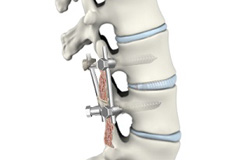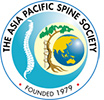
What is Lumbar Interbody Fusion?
Lumbar interbody fusion (LIF) surgery is a surgical technique that involves the removal of a damaged intervertebral disc and the insertion of a bone graft into the disc space created between the two adjoining vertebrae. Bone grafts promote healing and facilitate fusion. Screws and rods are used to stabilize the spine during the healing process.
Indications for Lumbar Interbody Fusion
Lumbar interbody fusion (LIF) surgery may be recommended for degenerative disc disease, spondylolisthesis, and disc herniation. The aim of the surgery is to alleviate back or leg pain and stabilize the spine.
Types of Lumbar Interbody Fusion
An interbody fusion can be performed with different approaches, which include:
- Anterior lumbar interbody fusion (ALIF): In this technique, the spine is approached from the front by making an incision over the abdomen.
- Posterior lumbar interbody fusion (PLIF): Your surgeon gains access to the spinal canal, disc and nerve roots from the back. In this procedure, the lamina is removed and the facet joints are trimmed to gain access to your spine.
- Transforaminal lumbar interbody fusion (TLIF): In this technique, the spine is approached from the side. This allows your surgeon to access the front as well as the back of your spine.
- Direct lateral interbody fusion (DLIF): In this approach, the spine is also approached from the side. Using a minimally invasive technique, the underlying soft tissues and the psoas muscle are gently separated to reach the intervertebral disc. As the spine is approached through the psoas muscle, DLIF is also known as the trans-psoas approach.
Before Lumbar Interbody Fusion
Before surgery, your doctor will discuss the type of procedure as well as its associated risks and benefits. Your doctor may also recommend a few blood tests, X-rays or other imaging tests to evaluate your medical condition.
Lumbar Interbody Fusion Procedure
- Lumbar interbody fusion may be performed using a minimally invasive technique, under general anesthesia with the assistance of X-ray or fluoroscopic guidance.
- Your surgeon may approach your spine from the back, abdomen or neck, depending on the area to be treated.
- During the surgery, your surgeon performs a discectomy, where a portion of the diseased or damaged disc material is removed. Next, a laminectomy is performed. The roof of the vertebra will be trimmed or removed to relieve pressure on the nerve.
- Following laminectomy, the bone graft (small chips of bone) will be placed between the vertebrae. Screws and rods are placed into the vertebrae to support the graft and promote the fusion of the vertebrae.
After Lumbar Interbody Fusion
Following lumbar interbody fusion, you will be shifted to the recovery room to closely monitor your vital signs. Minor discomfort, pain at the incision site, muscle spasms in the neck or back, or other related symptoms may be present after the surgery. You may need to wear a lumbar brace to support the spine during the healing process.
Postoperative Care following Lumbar Interbody Fusion
You will need to keep the incision area clean and dry. Do not swim or use hot tubs. Also avoid driving, smoking and lifting heavy objects. You can begin physical therapy as directed by your surgeon. You should take medications as prescribed by your surgeon and schedule a timely follow-up.
Risks and Complications of Lumbar Interbody Fusion
Infection, bleeding, nerve injury, and problems with anesthesia are the potential risks and complications associated with lumbar interbody fusion (LIF) surgery.
If you develop any signs of infection such as pain, redness, swelling or alteration in the quantity or smell of the drainage, or fever over 101°F, you should immediately call your doctor. Also, inform your doctor if you develop bowel and bladder dysfunction or numbness over the genital area.















